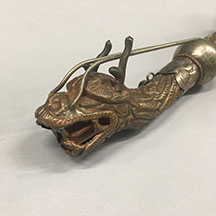

Detail of the makara head on the bell of Tibetan Buddhist kangling (MMA 68.59.91)
During Asian and Pacific American Heritage Month, we feature objects from Asia and the Pacific n the Maxwell's collections.
This brass and silver horn or trumpet, known as a kangling or rkang‐gling, was made in India for the Tibetan Buddhist market. Kangling horns are used in Tibetan Buddhist rituals to accompany chanting and welcome dancers.
Sound emerges from the open mouth of a brass figure on the "bell" end of the kangling. The figure, known in Tibetan as chu‐srin (Sanskrit: makara) is a mythical sea creature or dragon, with composite features of land and sea animals. In Tibet, the chu-srin is associated with water and rain. Although this piece is made of brass and silver, these horns were originally made with human femurs (thigh bones). The word “rkang” means femur, and “gling” means flute.
Check out this kangling at the Metropolitan Museum of Art, and be sure to click the “listen” button below the description to hear one being played. https://www.metmuseum.org/art/collection/search/505280